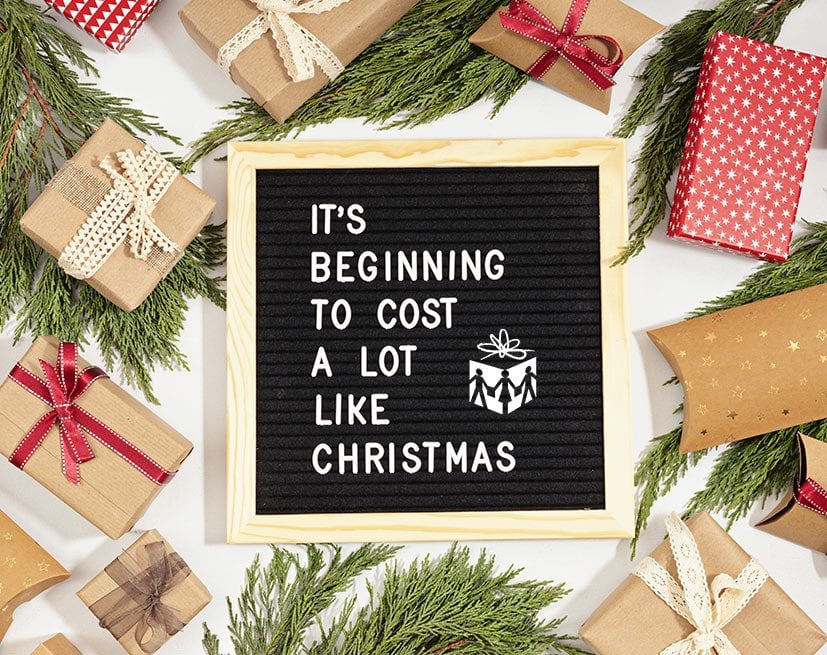Even though Christmas is on the same day every year it always finds a way of sneaking up on me when life gets busy. Which, let’s face it, seems to be quite often. November and December are always high-spending months for our family. Because of this, we decided we needed to create a savings account specifically for Christmas to help us prepare.
We’ve done this since our daughter was born and have made adjustments depending on how our overall budget was looking and what else was a high priority that year.
So how exactly do you go about creating a budget?
Here are a few things to consider…
How to create your Christmas budget
In my family, we use Google Sheets to track our budget, so both my husband and I have access to it. We update it throughout the year, as life throws us curve balls. To create a holiday spending budget, you must start with the total money you bring in every month. Then, calculate your total bills each month. Take the amount of money you have left over and determine how you want to allocate it. Most people put a portion towards emergency savings, entertainment, or travel. Decide how much you want to set aside for holiday shopping.
To determine how much you need to save consider doing the following:
- Gifts: List each family/friend you plan on spending money on and how much.
- Travel: Add in a travel budget for things like hotel stays, dining out, and transportation costs.
- Food/Drinks: Don’t forget to consider a special food budget for extras like holiday baking, turkey, seafood, and special wine/spirits.
- Deals/Regular Shopping: There are always really good deals this time of year. Consider any additional items you might need to purchase and take advantage of any Black Friday or end-of-the-year discounts to stretch your budget even further.
If you’re struggling to decide how much to set aside, look at past years to determine how much you typically spend. Divide this number by 12 to calculate how much you need to set aside each month. If this is too much, you can reduce it, knowing you will have a smaller holiday spending budget.
Set up multiple savings accounts
Try using a virtual version of the envelope method. Instead of using envelopes and cash, you can open multiple savings accounts. Then, each month, you will put money into each savings account. Label each savings account for different savings goals, such as holiday spending, vacations, emergencies, home projects, and whatever else you want. Dedicating money to each goal can help you stay focused on your savings goals by clearly showing your savings progress. It also makes you less likely to overspend in a particular area.
Look for a banking service like CaptialOne 360 or SoFi that offers high-yield savings accounts for the most benefit. These accounts will give you more interest earnings than a traditional savings account.
Schedule automatic deposits
Some banks let you schedule automatic deposits or transfers. Take the stress out of saving by scheduling automatic saving. Having the money automatically go into your savings account puts the money out of sight. Another option is to have your employer automatically place a portion of your paycheck into the savings account. By having the money go directly into the savings account, you won’t miss it because you never see it.

Use a budgeting and cash-back app
Consider adding an app or two that can help you budget and save during holiday gift shopping. Start with a savings app like Acorns. These apps make saving simple, helping you to get to set aside your spending budget quicker. Budget apps, like Goodbudget, help you use the envelope system to budget your spending. That way, you can plan your savings and spending.
When it’s time to do your shopping, consider using an app that gives you money back. Apps like Ibotta, Rakuten, Honey, and Fetch give you cash back for shopping. I like using cash back apps that also have a browser extension. That way, I can shop on any device and still get the benefit. Depending on what you buy, it could be a few cents or several dollars. Either way, it adds up and can help you maximize your budget. Another method for staying within budget is to use a couponing app. Using apps like Coupon Cabin or RetailMeNot can help you find coupons, promotions, or promo codes that can reduce the cost of an item.
Create online wish lists
Don’t waste your budget on gifts that the recipient doesn’t want. Instead, buy less and get everyone what they want most. Using online wish lists that you can share makes it easy to know exactly what everyone wants and makes it easier to plan your spending. Choose which items from everyone’s list you want to get them. Add them to a shopping list that you can stick to when shopping.
Shop throughout the year
One way to reduce the financial pressure of holiday shopping is to spread it throughout the year. That way, you aren’t buying all of your gifts in one or two months. You can set aside a certain monthly amount to buy a gift. Taking this approach also lets you take advantage of the sales that happen throughout the year. Sales happen during major holidays year round, making it possible to maximize your budget.
Talk about your budget
If you have a limited budget to work with, don’t be afraid to be honest with the friends and family in your life. Have a frank conversation with individuals about what you can afford and ask them for gift ideas that fit that budget. Another option is to suggest other gifting practices, such as exchanging handmade items, gifting an experience, or doing a group gift exchange. Our family does a white elephant gift exchange that turns the gift-giving into a shared experience that creates lasting memories.

Actively track your Christmas shopping spending
Create a method for tracking your spending. People often lose track of spending as they get swept up in the holiday spirit and marketing campaigns. They end up spending much more than they had originally budgeted. By creating a method for tracking your spending, you reduce the risk of overspending. If you spend more than you budgeted on a particular gift, you can immediately notice and adjust future purchases to account for the additional expenditure.
Some people find it helpful to keep all of their purchase receipts together. However, this can be tough if you make online and in-person purchases. I prefer a digital approach. Create a spreadsheet with everyone you plan to buy a gift for. Then, you can write what you bought and its price next to each person’s name.
How to stick to your budget
With all the incredible deals it can sometimes be easy to go overboard shopping for Christmas.
A gift registry, like Giftster, can be super useful when trying to keep your holiday budget in check. Make a family group and invite everyone to make their own wish lists. Then at a glance, you can see what items they are interested in and what they cost making it a breeze to stay on budget. And, not to mention, spending your money on gifts your family actually needs or wants.
Update your spreadsheet as you make purchases and keep a running total of how much money remains in your shopping budget. Rollover any extra money for the next year or consider donating to a special cause you care about.
Have a tight budget this year or a very large family? Consider encouraging your family to try a Secret Santa gift exchange. Every person still enjoys opening up a gift – without needing to spend money on every one.
Christmas doesn’t have to mean overspending or putting too much on a credit card. Start planning today to make your holidays an enjoyable time.
Happy gifting!










